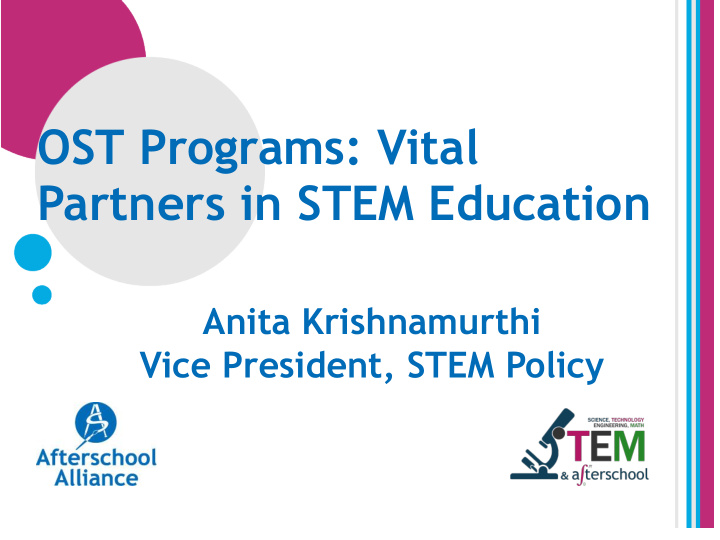



OST Programs: Vital Partners in STEM Education Anita Krishnamurthi Vice President, STEM Policy
When does learning occur? Credit: Life Center, Univ. of Washington
“Ecosystem for Learning” Social Supports • Parents • Friends • Educators Learning Environments • School • Afterschool & Summer Learner • Home • Science Centers & others Policy & Other • Federal Policy • National Standards
What the research says • Developing a science or STEM “identity” crucial (Tai, ASPIRES study) IDENTITY Value, Relevance
Defining appropriate outcomes Study results show that afterschool providers and supporters believe that afterschool STEM programs can support young people to: A B C Develop capacities Come to value the Develop interest to productively goal of STEM and in STEM and STEM engage in STEM STEM learning learning activities learning activities activities Full report available at: www.afterschoolalliance.org/STEM-PUBLICATIONS.CFM
Indicators of Progress 1 Active participation in STEM learning opportunities 2 Curiosity about STEM topics, concepts or practices 3 Ability to productively engage in STEM processes of investigation 4 Awareness of STEM professions 5 Ability to exercise STEM-relevant life and career skills 6 Understanding the value of STEM in society www.afterschoolalliance.org
Elements of quality Features of STEM Youth Activity the Learning Knowledge & Development Engagement Environment Practices in STEM STEM Organization Participation Content Relationships Learning Purposeful Materials Inquiry Relevance Activities Space Engagement Reflection Youth Voice Utilization with STEM
Impact of quality on outcomes • Program dosage is generally related to students’ science interest • Program quality is related to students’ science interest • Students attending science programs tend to report positive changes on indicators of social- emotional and 21 st century skills
Resources – Networks & Intermediaries
Resources (contd.) • Curricula • Partners o Science Centers, Universities, Government Labs, Corporations (see AA issue brief) • Assessment – Quality of programs – DoS tool, STEM PQA o Youth outcomes – Common Instrument, o Assessment Tools in Informal Science (ATIS; http://www.pearweb.org/atis)
Learn more! • Website - www.afterschoolalliance.org/STEM • Examples & Models – STEM Storybook • akrishnamurthi@afterschoolalliance.org; Follow Us Like Us Read Us @afterschool4all /afterschoolalliancedc Afterschool Snack Blog
Afterschool 101 8.5 million children in afterschool programs • 15 million unsupervised • Demand outstrips availability • ______________________________________________________ Girls participate in equal numbers to boys • African-American & Hispanic children participate in • greater numbers • Children in federally funded afterschool programs participate for average of 14.5 hours/week ______________________________________________________ Benefits of afterschool well-known: • o Improved attendance, class behavior & coursework o Helps working parents & worker productivity Huge support from voters •
Sub-Indicators (specific, measureable) High Confidence Medium Confidence • Active engagement and focus in STEM • Understanding of STEM methods of learning activities investigation • Knowledge of how to pursue STEM • Ability to work in teams to conduct careers STEM investigations • Mastery of technologies and tools • Active inquiries into STEM topics, that can assist in STEM concepts, or practices investigations • Understanding of the variety of STEM • Knowledge of important civic, careers related to different fields of global, and local problems that can study be addressed by STEM • Understanding of relevance of STEM • Pursuit of in-school STEM learning to everyday life, including personal opportunities life • Awareness that STEM is accessible • Demonstration of STEM skills to all • Applied problem-solving abilities to • Active information seeking about conduct STEM investigations mechanical or natural phenomena • Awareness of opportunities to or objects contribute to society through STEM • Demonstration of STEM knowledge
Recommend
More recommend